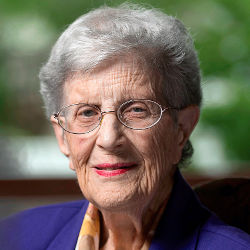
Jean E. Sammet, an American computer scientist who served as the first female president of ACM, passed away on May 21 at the age of 89.
Sammet was born March 23, 1928 in New York City. She received a bachelor’s degree in mathematics from Mount Holyoke College in 1948, and a master’s degree in that discipline from the University of Illinois at Urbana-Champaign in 1949.
In 1951, Sammet joined Metropolitan Life Insurance, but left to pursue a doctorate in mathematics at Columbia University. She worked as a teaching assistant at Barnard College for a year, before deciding to leave academia. (She did not complete doctoral studies, but received an honorary doctor of science degree from Mount Holyoke in 1978).
From 1953 to 1958, Sammet was a mathematician for Sperry Gyroscope (now part of Unisys) in New York, working on mathematical analysis problems.
In 1955, the company asked her to program the Sperry Electronic Digital Automatic Computer. Sammet became leader of an "open shop" of programmers acting as consultants to engineers and working with scientists who assisted them in writing and testing routines.
Sylvania Electric Products hired Sammet in 1958 to oversee software development for the U.S. Army’s Mobile Digital Computer. She served as staff consultant for programming research, and was a member of the original COBOL group.
In 1961, she moved to IBM, where she researched the use of restricted English as a programming language and the use of natural language for mathematical programs.
During the mid-1960s, Sammet developed FORMAC (Formula Manipulation Compiler), the first widely used computer language for symbolic manipulation of mathematical formulas.
ACM Activities
Understanding the importance of exchanging information with others working with languages and software, Sammet contacted ACM’s then-president George Forsythe, who named her chairperson of the Special Interest Committee on Symbolic and Algebraic Manipulation (SICSAM, later the Special Interest Group on Symbolic and Algebraic Manipulation, SIGSAM).
In 1966, Sammet was elected ACM’s Northeast Regional Representative. She was also a member of the ACM Council, and was named ACM lecturer in 1967, 1968, and 1972. In 1968, Sammet was named chairperson of the ACM Committee on SIGs and SICs.
In 1971, she was elected chair of the ACM Special Interest Group on Programming Languages (SIGPLAN), a post she resigned when elected vice president of ACM in 1972.
While vice president, ACM’S then-president Anthony Ralston asked her to chair the first ACM Long Range Planning Committee (LRPC). In 1974, Sammet was elected the first female president of ACM, and continued to work with the LRPC. A final report from the committee recommended principles to be used as guidelines for ACM activities.
In 1975, Sammet was named an honorary member of Upsilon Pi Epsilon, the International Honor Society for the Computing and Information Sciences.
In 1977, she organized and chaired the first History of Computing Committee for the American Federation of Information Processing Societies, which encouraged the creation of archives for industry professionals’ materials. Said Sammet, "From childhood on, I hated to throw papers away. As I became an adult, this characteristic merged with my interest in computing history. As a result, I created important files and documents of my own, and became concerned with having other people publish material on their important work so the facts (rather that the myths) would be known publicly."
ACM celebrated Sammet in 1985 with its Distinguished Service Award "for advancing the art and science of computer programming languages and recording its history. "
Sammet retired from IBM in 1988. She served on the board of directors of the Computer History Museum 1983–1993, and on the board and executive committee of the Software Patent Institute 1991–1998.
In 1989, the Association for Women in Computing presented Sammet its Ada Lovelace Award.
In 1994, Sammet was named a Fellow of the ACM.
In 1997, she shared SIGPLAN’s Distinguished Service Award with J.A.N. Lee.
In 2001, Sammet was named a Fellow of the Computer History Museum.
In 2009, IEEE gave her its Computer Pioneer Award "for pioneering work and lifetime achievement as one of the first developers and researchers in programming languages."
In 2013, the National Center for Women & Information Technology (NCWIT) bestowed its Pioneer Award on her.
Sammet maintained an enormous collection of materials on programming languages, which were to be housed at the Charles Babbage Institute Center for the History of Information Technology at the University of Minnesota upon her demise.
—Lawrence M. Fisher



Join the Discussion (0)
Become a Member or Sign In to Post a Comment